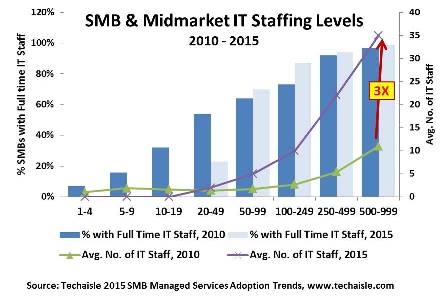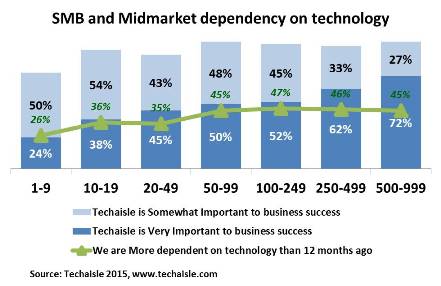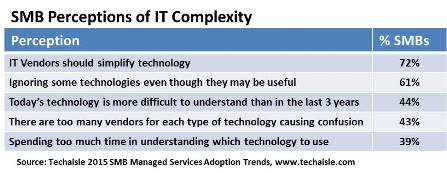Cisco and the SMB market
Cisco has established an undisputed leadership position in the enterprise market. The company combines a widely-adopted and well-integrated portfolio of networking products with a highly-skilled (and paid) direct sales force to manage/expand its presence within major accounts.
The SMB market is a separate challenge. Here, buyers are less likely to require integration across multiple network components and more likely to emphasize price. They are also more likely to receive advice/management from channel partners, further reducing Cisco’s control over the acquisition process.
Against this backdrop, Techaisle’s SMB Channel Trends research illustrates the strengths and challenges Cisco must manage, as it looks to expand its share in the SMB segment.
Cisco Commands High Trust and Reputation
Within the channel community, Cisco enjoys a sound reputation and a high degree of trust. Techaisle’s latest SMB channel partner survey shows that 78 percent of Cisco’s SMB channel partners trust Cisco, a higher percentage than is registered by competitors such as HP and IBM. Nearly 70 percent of the partners believe that Cisco has quality products – again, the highest ranking recorded within the ‘hardware leader’ group including Cisco, HP, IBM and others. However, only 52 percent mention that Cisco has cutting edge technology, a percentage lower than that for both IBM and Microsoft. Moreover, 60 percent of Cisco’s SMB channel partners say that they Like Cisco, lower than corresponding rates for HP and Microsoft, only slightly higher than is found for IBM.
In its 2013 Annual report Cisco has written, “A substantial portion of our products and services is sold through our channel partners, and the remainder is sold through direct sales.” With specific reference to SMBs, Cisco wrote, “Generally, we define commercial businesses as companies with fewer than 1,000 employees. The larger, or midmarket, customers within the commercial market are served by a combination of our direct salesforce and our channel partners. These customers typically require the latest advanced technologies that our enterprise customers demand, but with less complexity. Small businesses, or companies with fewer than 100 employees, require information technologies and communication products that are easy to configure, install, and maintain. These smaller companies within the commercial market are primarily served by our channel partners.” Techaisle’s data shows that Cisco has attracted positive attention within this channel partner community, but that its technology and relationships do not leave it especially differentiated from competitors.
Technology Shift has Created SMB Messaging Challenges
In recent years SMB technology demands have shifted to cloud, mobility, analytics, social media, collaboration, managed services and virtualization. Cisco is seeking to capitalize on this market transition through the development of cloud-based product and service offerings that enable its customers develop and deploy their own cloud-based IT solutions.
In communications channel partners in the U.S. including those specializing in the SMB segment – Cisco has been steadily driving them to offer products and services that deploy cloud, mobility, virtualization, managed services and data center solutions. This is by no means an easy task as most SMB channel partners are being actively courted by competitive vendors that also want to grow their emerging technologies’ business. SMB channel partners selling advanced technologies have an average of 3.46 vendor partnerships which average jumps to 4.21 for Cisco SMB partners, a difference of 21 percent. With this increased contention for mind/market/wallet share, it can be difficult for Cisco to manage brand identity and its related messaging.
This difficulty is illustrated by study findings showing that of all the Cisco SMB channel partners, 44 percent consider Cisco to be their top partner. The other 56 percent mention Microsoft, Oracle, HP, IBM and several others. Within the VAR/SI community, Cisco’s share of preference is 48 percent and drops to 39 percent amongst the MSPs/SPs that are viewed as critical to the success of future cloud initiatives.
Cisco’s SMB Channel Partner Brand Equity
Techaisle believes that it is time for a new metric to represent presence (and opportunities for growth) within the SMB market. Techaisle refers to this second-generation measurement approach as Brand Equity Management. It is measured by a robust proprietary index, the Techaisle Brand Equity Score (BES-360).
Techaisle believes that it is important for IT vendors to measure their Brand Equity within SMB channel partners as well as SMBs. Techaisle’s Brand Equity Score, BES-360, helps to identify areas where IT vendors can improve to increase share of wallet. BES-360 is a KPI (Key Performance Indicator) that measures the strength of brand within a segment.
Cisco’s Brand Equity Score within its SMB channel partners is higher than most competitors – but lower than scores for both IBM and Microsoft. The implication of these findings is that even through Cisco has high brand equity amongst its channel partners; it is not necessarily true that its entire SMB-focused channel base is firmly wedded to Cisco’s game plan.
SMB Channel Partner Brand Equity Measurement– the New Prescription
Breaking down the data for Cisco, Techaisle’s study finds that almost 25 percent of Cisco’s channel partners have a Brand Equity rating of 80+. This group forms Cisco’s core partners. The data also shows that almost 35 percent of Cisco’s SMB channel partners have equity of less than 40. These are the partners that Cisco needs to work on.
Interestingly, small business focused channel partners give a higher Brand Equity Score to Cisco than mid-market focused channel partners. This is a segment that Cisco should address as the mid-market has become a battleground for most IT vendors and there is yet no clear dominant player.
Among all SMB channel partners of Cisco, VARs are actually driving up the Brand Equity Score. In fact 41 percent of VARs constitute the HBE (High Brand Equity) group. On the other hand, MSPs constitute only 20 percent. In order for Cisco to continue to grow its CMSP program and build on its initial successes, Cisco has to turn its attention to the MSPs that serve the SMBs to understand the key reasons for lower brand equity which when fixed can lead to better wallet share among MSPs.
Drilling down further into the data, Techaisle finds that Cisco is not doing better within the overall managed services community than it is within MSPs focused on cloud. A higher percentage of Cisco’s HBE partners are offering managed services to SMBs whereas a higher percentage of ABE (Average Brand Equity) partners are offering Cloud to SMBs. Cisco’s SMB cloud ambitions would benefit from moving some of these ABE cloud partners to HBE segment. The HBE segment offering cloud services need extensive training on cloud solutions to become more successful in offering cloud to their SMB customers. More than 40 percent of these channel partners are working with SMB customers that have private cloud. This may be good for Cisco in the short-term but it does not represent best practice in this segment, and it is misaligned with the ongoing acceptance of public cloud as a preferred IT delivery platform.
Product resale revenue is 43 percent for HBE partners as compared to 38 percent for ABE. Similarly, recurring revenue is 57 percent for HBE as compared to 61 percent for ABE. Naturally, this bodes well for Cisco’s current revenue as the High Brand Equity partners are driving higher revenues from products. However, if Cisco plans to increasingly promote service-centric partners then a lot more work is required to identify partners with higher services revenues and move them into the High Brand Equity segment.
Practicing the Prescription
Techaisle’s brand management work is anchored in the belief that if a vendor’s brand equity is good, then it can compete successfully with vendors with lower brand equity for sales of comparable products or services. Vendors with sound products/services but low brand equity will struggle to maintain parity with competitors that have higher brand equity, even if that vendor’s products/services are (somewhat) inferior. Hence, Brand Equity Score findings help indicate potential areas of expansion or exposure as vendors, like Cisco, assess their potential for expanding the footprint of their brands within the SMB channel partner community. The composition of Cisco’s BES across its channel indicates the core strength of its brand. Techaisle’s analysis indicates that Cisco has both strengths to build on and areas requiring focus as it moves to position its next-generation solutions (especially, cloud solutions) through its channel to the SMB market.














